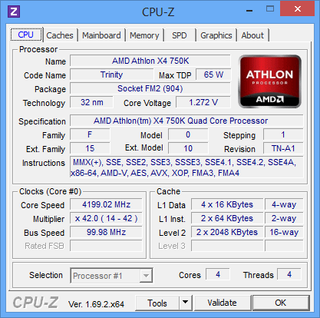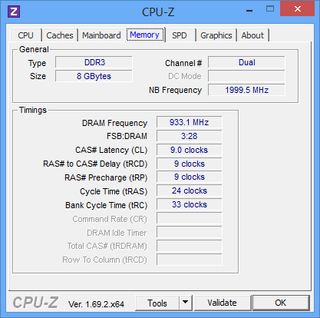System Builder Marathon, Q2 2014: Our Budget Gaming PC
Overclocking Our Budget AMD Platform

I prioritized quiet operation for the stock configuration, unplugging the side-panel fan and enabling control in ASRock's UEFI to bring the remaining coolers down in speed. The CPU's stock voltage is 1.225 V, but reported voltages within Windows fluctuated between 1.208 and 1.256 V under load using HWMonitor. There was a even more variance per core within AMD's OverDrive utility. Power-saving features and Turbo Core were enabled.
When it came time to overclock, I chose to disable Turbo Core and run the fans at 100%. By far, the loudest sound from the system was its side-panel intake, which had that aforementioned whine (rather than the expected whoosh of moving air). But a 120 mm blower pushing fresh air down onto the socket interface was comforting, so it remained.
I wasn’t expecting high frequencies from the Athlon X4 750K, since it was handicapped by a puny boxed heat sink. We lucked out, though, finding 4 GHz stable on all cores at the stock voltage setting. Thermals looked good, so I started bumping the voltage up a little at a time. Stability at 4.2 GHz only required 1.272V under load, which was achieved with a +0.048 V offset and enabling APU LLC to stabilize power delivery.

Next, I sought to maximize gains by overclocking the RAM. DDR3-1866 with CAS 9 timings required 1.625 V for stability. I bumped the CPU-NB frequency to 2000 MHz, which is a modest boost that didn't require altering the Northbridge Voltage option. Everything was tested for stability as I kept an eye on thermal margin from within AMD's OverDrive utility, as well as spot-checking the motherboard's VRM with an IR thermometer.

OverDrive reported another 25 degrees of thermal margin available under Prime95. But I wasn’t comfortable pushing higher voltages, especially with higher summer temperatures on the way. Still, I have to be happy with these results considering two of our lab's 750Ks top out just 100 MHz higher at 1.425 V and topped with aftermarket coolers.
Next, I wanted to tweak MSI's Radeon R7 265 using the latest version of Afterburner. The GPU's official limit is 1050 MHz, which I hit without the need for additional voltage. The card's memory wasn't as cooperative though, causing instability at 1480 MHz. I dialed it back down to 1450 MHz (5800 MT/s).

The final overclock was filtered through MemTest 86+, Prime95, and an hour of gaming before receiving a stamp of approval and proceeding to the benchmarks.
Stay On the Cutting Edge: Get the Tom's Hardware Newsletter
Get Tom's Hardware's best news and in-depth reviews, straight to your inbox.
Current page: Overclocking Our Budget AMD Platform
Prev Page Assembling Our Gaming Box Next Page How We Tested Our Budget Gaming PC-
LookItsRain I myself just could not see buying a setup like this because of complete lack of a CPU upgrade path.Reply -
revanchrist Please stop those nonsenses so called upgrade path. People who buy budget pc won't upgrade their pc before 2-3 years of usage at least. And by the time they are actually upgrading, they will be buying new CPU and new motherboard aka a whole new platform. But still i'll say a combination of G3258 + H97 and overclock it or a i3 4150 + H97 without overclocking will be a better option.Reply -
bemused_fred THANK YOU for finally including the cost of the OS! This is a HUGE budget consideration, ESPECIALLY for those working on low-cost builds.Reply -
Electromikey I'm personally not surprised at all that the ASUS burner was DOA. I've owned four of them, and each one has died within a month of purchase. Not a fan.Reply -
Steve Simons I'd love to see a "vote on the components" build at some point. Each decision would have 3-5 choices with your analysis of why a choice might be good or bad. Then, as readers and enthusiasts, we can vote for our choice and see what wins.Reply -
allanitomwesh Liking the new format and for once,I actually agree with the choices made on this rig!Good show there henningsen,I think it is important to consider that this month's rig,compared to last time at $750,has enough difference in price to graba monitor and keyboarg mouse combo,for a complete system,and that is a win.Reply -
Steve Simons I'm not an expert by any means, so take this with a grain of salt. Would dumping the RAM down to 4 GB have opened up the better graphics card?Reply
The reason why I ask is that budget builders, if they do choose to upgrade anything, typically upgrade RAM (due to the extreme ease at which it can be installed). This way, as they save their pennies they can make the jump from 4 GB to 8 GB while still having the better graphics card that should serve them a bit better and longer than the one in the current system. -
Traciatim I hope you stick with the budgets in the future, it seems pretty silly comparing machines from quarter to quarter with wildly fluctuation budgets. It's also nice that budget actually means entry level budget and that the cap is $1500. It seems like after that amount it just ends up throwing money at things because they sound cool rather than really changing the performance of the machine all that much.Reply
Hopefully next time we will get the see the G3258 in the budget gaming rig since even Tom's own article showed the 3258 pretty much destroying the 750k in games across the board . . . or maybe AMD could come up with something that's actually worth buying over other offerings? -
pauldh Reply13573428 said:I'm not an expert by any means, so take this with a grain of salt. Would dumping the RAM down to 4 GB have opened up the better graphics card?
The reason why I ask is that budget builders, if they do choose to upgrade anything, typically upgrade RAM (due to the extreme ease at which it can be installed). This way, as they save their pennies they can make the jump from 4 GB to 8 GB while still having the better graphics card that should serve them a bit better and longer than the one in the current system.
Actually, you are right on target. This is a big decision for budget-buyers to consider. And here is where I was most torn also. For me it somewhat comes down to current market prices. The way they rise and fall you may grab an 8GB kit later on for the price of a 4GB kit now. Though the reverse has already happened too. We bought 8GB kits for way less in the past. If budget/funding forced me under R7-260X, I'd have dropped to 4GB.
In this SBM series we run our benchmark workloads from the HDD, not RAM Drive, so it (dropping to 4GB)wouldn't show up in our benchmark charts much at all (beyond a few apps, tops). Yet jumping to R9 270 would have yielded notable gains in frame rates, and even offered higher max playable settings. Yet it also feels like a bit of a cheat on my part; a benchmark win, yet also a "daily livability" loss.
IMO computing life with 4GB isn't as productive or enjoyable. Stuttering or hitching in games, lengthened time just to exit games or switch between tasks, and even web browsing slowing to a crawl when too many tabs are open.
I got in the habit of outfitting 8GB when RAM was more affordable, especially when the entry-level mobo in use is limited to two sticks. This one supports four, so starting with 4GB becomes more practical. There's some potential for compatibility issues when adding very different memory kits. (single-sided+dual-sided) But nothing I'd worry too much about.
I'd say budget builders more than anyone should consider building in steps. That's one good reason to build rather than buy. Be it the mobo, CPU, Graphics, PSU, RAM, It's nice know part(s) of your platform has/have staying power, even if you can't afford to do it all well, right from the start.
-
pauldh Reply13572758 said:Please stop those nonsenses so called upgrade path. People who buy budget pc won't upgrade their pc before 2-3 years of usage at least. And by the time they are actually upgrading, they will be buying new CPU and new motherboard aka a whole new platform. But still i'll say a combination of G3258 + H97 and overclock it or a i3 4150 + H97 without overclocking will be a better option.
While I most certainly understand what you are saying, considering the double post directly above it, I'd also like to reiterate budget builders are the ones who should probably MOST consider the upgrade path. If you can afford to hit the upper-mainstream now across the board, fine. You may likely be happy for a few years until your next build. Or at least you'd have the platform to stay with a GPU upgrade, if desired.
But if you can't, then why settle for the disposable platform mentality and not consider advantaging upgrade potential into your plan? Remember some folks aren't keen on starting over with a fresh OS all to often. A large CPU bump while retaining the mobo, can be a huge plus for those who always feel they lack free time. Starting with a Pentium and later popping in Core i7 has huge lasting potential for those short on cash only, but not in computing desires. For my son, I even started with Celeron so he could build his own with me, and now that rig outfits i5-2500K, and the Celeron ported over to a cheap office PC. It was part of the plan all along, but the cheap chip got us up and running quicker within my budget. Best of all, it only took me minutes to upgrade.
